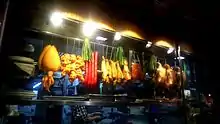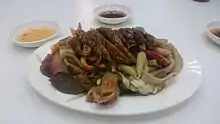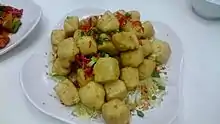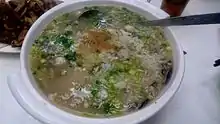Daa laang (Chinese: 打冷; Jyutping: daa2 laang1; Cantonese Yale: dálāang) refers to a night-time meal in Hong Kong cuisine. First emerging in the 1950s, daa laang includes hot and cold Chiuchow dishes.
Origins
Daa laang originated from Chiuchow (Teochew, pinyin Chaozhou) and is therefore also called Chiuchow daa laang (潮州打冷). In the 1950s, the cuisine was introduced to Hong Kong by Chiuchow immigrants.[1]

The traditional way to order food is to choose the dish of one's choice in front of a server, who then marks it down for the customers. The daa laang is then made and sent to the table. Due to its convenience and unique taste, the traditional repast is fast expanding outside of Hong Kong and into China, including Shenzhen.[2]
Etymology
The term is Cantonese and originated in Hong Kong. There are several proposed etymologies:
- In the fiction of the Song and Yuan dynasties, terms such as da tsim (Chinese: 打尖; Jyutping: daa2 zim1; Cantonese Yale: dá jìm) and “da dim” (打店; daa2dim3; dá dim), refer to going to a restaurant for dinner while traveling. Hence, the word daa (打), literally "hit", can refer to eating at a restaurant. In the Chiuchow dialect, the word lang means "people." Thus, Cantonese refer to the Chiuchow people as lang lo (冷佬; laang5 lou2; làang lóu). Over time, lang lo became a slang term, referring Chiuchow food stalls. Then gradually the term daa laang referenced dinner at Hong Kong’s Chiuchow stalls.
- In the 1950s, there were many Chiuchow people selling late-night supper and marinated food, first near Triangular Pier (三角碼頭), then in other places of Hong Kong's streets. The sellers carried baskets with poles on their shoulders and peddling along the streets. They were called the basket carriers(擔籃), which was a common scene in native Chiuchow area. The pronunciation of this term in the Chiuchow dialect is similar to daa laang(打冷), so then Hong Kongers began to call them the daa laangs. In time, daa laang became the term that represents eating Chiuchow cuisine in Hong Kong. The reason why the term basket carriers (擔籃) becomes daa laang(打冷) was because the basket carriers would shout the foods they were selling and the buyers, at the beginning mainly the pier workers in Triangular Pier, would shout back "come here the basket carriers" (擔籃個過來) or simply "basket carriers" (擔籃). To the majority Hong Konger, they couldn't understood Chiuchow language and mistaken the expression basket carriers (擔籃) as daa laang (打冷).
- At that period, many gangs dined and dashed at Hong Kong's Chiuchow stalls. A Chiuchow gang formed in response to watch for the rival gangs. Once they found someone who came for a meal, they would yell "hit them!" to alert others. As daa laang in Chiuchow dialect sounds like "hit them" , people gradually associated daa laang with Chiuchow people.
Dishes
Dishes include a variety of cold cuts and spicy dishes originating from the food stalls in Chiu Chow. Marinated food, seafood, pickled products, and cooked dishes are the four main types of Daa Laang.



One popular dish is the marinated or Chiu Chow soy-sauce goose. People usually order marinated tofu and cuttlefish together with the goose or directly order a marinated combination.
Pepper and salt fried food served with chili is also popular. Chefs will first fry the particular food (usually a light food like tofu or squid) and then re-fry it with pepper and salt.
Popular hot items include oyster congee, prepared by adding chopped meat and dried flatfish into the congee; pan fried oyster cake, prepared by adding oyster meat into an egg and frying it; lemon flat head mullet, prepared by adding lemon pieces into the mullet and steaming; and Chinese kale and beef served with special Satai sauce.
Popular cold items include iced cockle, made by first boiling and then freezing and served with a sauce made with garlic, sugar and vinegar, and iced crab, which is first boiled and later frozen.
References
- ↑ "Daa Laang - Cuisine of China". Trek Zone. Retrieved 2022-09-29.
- ↑ "潮汕美味大搜索", Retrieved 18 June 2012